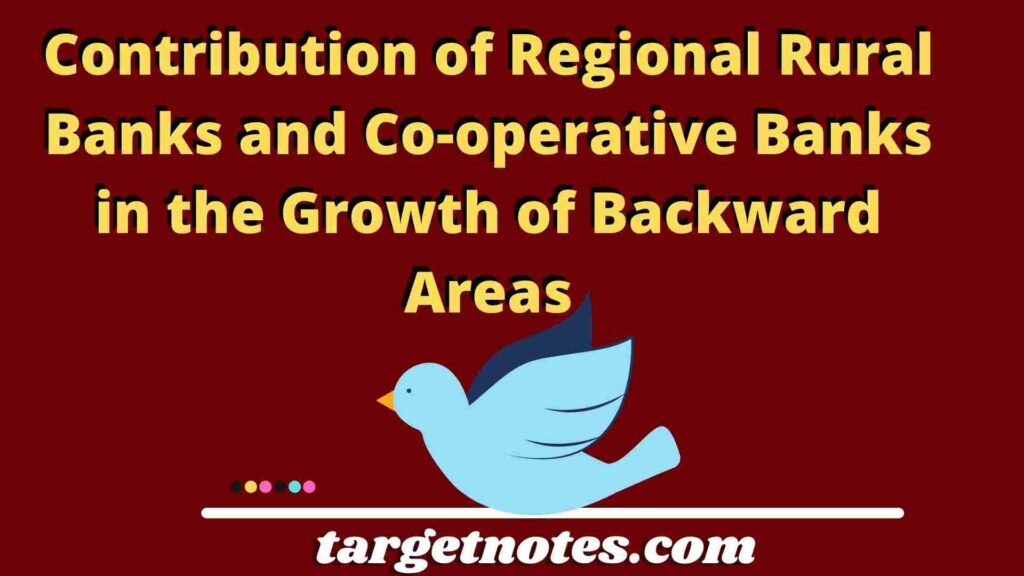
Contents
Contribution of Regional Rural Banks in the Growth of Backward Areas
Regional rural banks are pivot of economic development of backward rural areas. Regional rural banks were established to provide credit to the rurals who are economically weak. RRBs provided credit to small and marginal formers, artisons, agricultural labours, and even small entrepreneurs. RRBs plays their role in the development of backward rural areas as under:
1. Extension of Branch Network to the Unbanked Rural Areas: Regional rural banks have succeeded in extending their branch network to the unbanked and under banked rural areas.
2. Extension of Credit: RRBs have made significant progress in deposit mobilization, and in extension of credit particularly among the poors of backward rural areas.
3. Special Schemes: Regional rural banks have played an important role in the implementation of various special scheme e.g. Integrated Rural Development Programme.
4. Self Help Groups: RRBs involvement in Self Help Groups have increased financial inclusion at more than faster rate than it was before.
5. Collection of Small Savings: Regional rural banks have played a remarkable role in the rural development of the country. They have contributed in collecting small savings and helped in the formation of capital. They have recruited staff from rural areas and have given employment to rural masses. They were helpful in expansion of rural employment scheme.
RRBs have followed the loan policy prepared by Government of India and they have followed the instructions, issued by the Govt. for time to time. The main aim of establishing RRBs was to make progress in the field of agriculture, trade, commerce, industry and in other production areas and to develop the rural sector, RRBs have successfully attained these aims, RRBs. had provided loan facilities to small farmer and they have created an idea in the minds of rural people that it is a bank meant for rural.
Contribution of Co-operative Banks in the Growth of Backward Areas
A co-operative bank is an institution to provide credit but they also mobilize savings from member and non-members. The co-operative credit is catered by the banking system that comprises of primary agricultural credit societies, central co-operative banks and state co-operative banks to serve the rural areas and primary co-operative banks. At the long end of rural credit there are regional rural development banks and at the apex level there is National Bank for Agriculture and Rural Development.
The primary agricultural credit societies provide short term and medium term credit to rural peasants at grass root level. Co-operative credit societies foster the habit of savings by depositing their savings in these societies. These societies undertake following activities for the growth of backward areas people :
- Distribution of fertilizers, seeds and other inputs,
- Help to dairy owners,
- Help to poultry, goat and other local raw materials.
These societies also give loans for personal needs of its members.
Central co-operative banks sanction short-term credit to member credit societies to lend to their members and the also provide medium-term loans to credit societies. The district central co-operative banks contribute in the development of backward areas in the following ways:
- Providing loans to individual customers against tangible securities,
- Encourage savings by paying higher interest,
- Providing remittance facilities and issue drafts,
- Providing cheque collection and clearance facility,
- Supervising and controlling of member societies,
- Helping proper utilization of surplus funds of societies.
State co-operative banks are apex banks of primary credit societies and district co-operative banks. State co-operative banks arrange finances for co operative system in the state. They help in maintaining balance among various district banks by transferring funds from surplus districts to deficit districts.
Thus, primary co-operative societies, district co-operative banks, state co-operative banks etc. provide important services in backward rural areas.
Related Link
- Describe the various types of money
- Dynamic Functions of Money
- Evils or Demerits of Money
- Importance and significance of money in Modern Economy
- Approaches regarding Definitions of Money and its Function
- Money: Meaning, Definitions and features of Money
IMPORTANT LINK
- What is the Exchange Rate System in India?
- Evolution of foreign exchange market in India
- Meaning and importance of export finance.
- Role of Export-Import Bank in Financing India’s Foreign Trade
- How Commercial banks Export Finance to Overseas Importers?
- Explain packing credit in detail?
- What is Post-shipment credit?
- What is Pre-shipment or packing credit?
- Explain Export Credit in India?
- Institutions Providing Finance and Credit Facility for Foreign Trade
- What is Risk Analysis?
- Explain Political risks in detail? and its Types
- What are the types of Risks. Explain in detail?
- Meaning and Types of commercial risks
- How can we minimize foreign trade risks?
- What are Arbitrage operations?
- Difference between Spot Market and Forward Market
- What is spot exchange?
- Agency agreement: Meaning, Features and Advantages
- Functions of Foreign Exchange markets
- structure of Foreign exchange markets
Disclaimer






